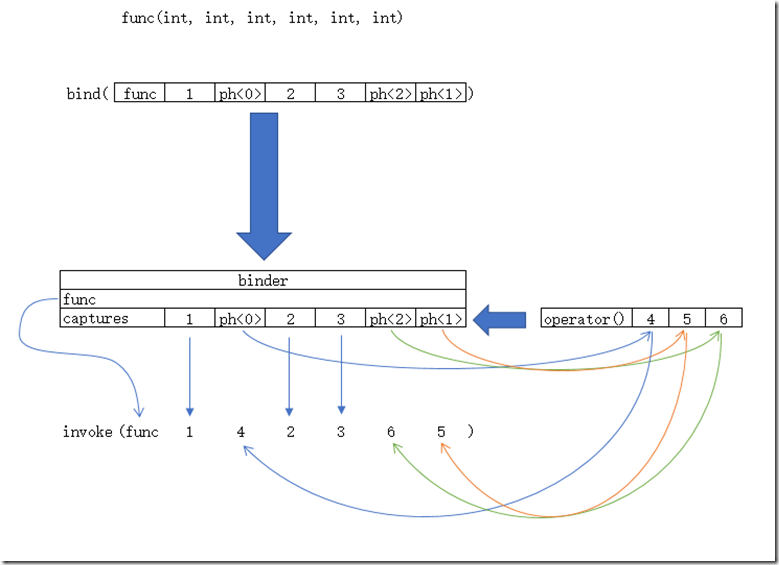淺談std::bind的實現
bind這個東西爭議很多,用起來很迷,而且不利於編譯優化,很多人都推薦用lambda而非bind。簡單說,bind就是通過庫抽象實現了lambda裏需要寫進語言標準的東西,變量捕獲,參數綁定,延遲求值等。但是以此帶來的缺陷就是,雖然bind生成的可調用對象的結構是編譯期確定的,但是它的值,尤其是被調用的函數,全部是在運行期指定的,並且可調用對象也只是一個普通的類,因此很難進行優化。除此之外,標準庫的bind實現,只提供了20個placeholder進行參數綁定,無法擴展,這也是實現的一個坑。因此,在有條件的情況下,應該使用lambda而非bind,lambda是寫入語言標準的特性,編譯器面對一個你寫的lambda,和bind生成的普通的對象相比,可以更加清楚你想要做什麽,並進行針對性的優化。
雖說如此,bind怎麽實現的還是很trick的,這篇文章就講一講bind的實現。
bind的使用
bind的使用分兩步,第一步是生成可調用對象,使用你想要bind的東西和需要捕獲和延遲綁定的參數調用bind,生成一個新的callable。
std::string s;
auto f = mq::bind(&std::string::push_back, std::ref(s), mq::ph<0>);
這裏用的是我自己的實現,bind的第一個參數是你要綁定的callable,這裏是一個成員函數,後面的是用來調用的參數,因為是一個成員函數指針,所以參數的第一個應該是一個對象實例,這裏是一個引用包裝的字符串
std::ref(s)
最後是一個placeholder,他表示對於生成的可調用對象,在調用時第0個參數要被傳到這裏。這裏和標準不一樣,標準的placeholder是從1開始的。
使用起來就是這樣的
f(‘a‘); f(‘b‘);
這裏用來調用的參數就會被傳給綁定進去的push_back的第0個參數。
bind的實現
首先就是bind生成的對象,要做的就是把callable和後面傳的參數都丟進一個類裏面,這樣就構成了一個綁定對象,bind是這麽實現的,lambda的內部也是這麽實現的。生成的對象叫binder。
template<class TFunc, class... TCaptures> class binder { using seq = std::index_sequence_for<TCaptures...>; using captures = std::tuple<std::decay_t<TCaptures>...>; using func = std::decay_t<TFunc>; func _func; captures _captures; public: explicit binder(TFunc&& func, TCaptures&&... captures) : _func(std::forward<TFunc>(func)) , _captures(std::forward<TCaptures>(captures)...) { } //...
這個實現相當的直接,func就是被綁定的函數,captures是一個tuple,裏面裝了bind調用時第1個參數後面的所有參數,構造函數把這些東西都forward進去存住。註意所有的類型參數都decay過,這是因為要去掉所有的引用,數組退化成指針,不然沒法放進tuple。
而bind,簡單點,就是用調用的參數構造binder而已。
template<class TFunc, class... TCaptures> decltype(auto) bind(TFunc&& func, TCaptures&&... captures) { return detail::binder<TFunc, TCaptures...>{ std::forward<TFunc>(func), std::forward<TCaptures>(captures)... }; }
這裏用了C++14的decltype(auto)返回值,這個寫法就是通過return語句直接推斷返回類型,並且不做任何decay操作。
binder構造好了,下面就是構造它的operator()重載,函數簽名也是相當的直接:
//class binder template<class... TParams> decltype(auto) operator()(TParams&&... params); };
接受不定數量的參數而已,這裏不同於標準的實現,我沒有用任何的SFINAE來做參數的限制,如果調用的參數有錯,那麽大概會出一大片編譯錯誤。
它的實現是這樣的,我把上面binder的實現再復制過來一份一起看
template<class TFunc, class... TCaptures> class binder { using seq = std::index_sequence_for<TCaptures...>; using captures = std::tuple<std::decay_t<TCaptures>...>; using func = std::decay_t<TFunc>; func _func; captures _captures; public: explicit binder(TFunc&& func, TCaptures&&... captures) : _func(std::forward<TFunc>(func)) , _captures(std::forward<TCaptures>(captures)...) { } template<class... TParams> decltype(auto) operator()(TParams&&... params); }; template<class TFunc, class... TCaptures> template<class... TParams> decltype(auto) binder<TFunc, TCaptures...>::operator()(TParams&&... params) { return bind_invoke(seq{}, _func, _captures, std::forward_as_tuple(std::forward<TParams>(params)...)); }
這裏operator()的實現就是調用的bind_invoke,參數是什麽呢,一個index_sequence,之前綁定好的函數和捕獲參數,和這裏傳入的參數列表,參數列表也轉發成tuple,為什麽要做成tuple呢,因為tuple好用啊,後面就看出來了。
bind_invoke獲得了上面這一大坨,它來負責params和_captures正確的組合出來,拿來調用_func。
我們像一下_func應該怎麽調用,這裏可以使用C++17的invoke,
invoke(_func, 參數1, 參數2, ...)
而這些參數1,參數2,是怎麽來的呢,回去看一下調用bind時的captures,如果這個capture不是placeholder,那麽這個就是要放進invoke的對應的位置,而如果是placeholder<I>,那麽就從params裏面取對應的第I個參數放進invoke的位置。
畫個圖就是這個樣子的:

那麽,怎麽實現這種參數的選擇呢,通過包展開
template<size_t... idx, class TFunc, class TCaptures, class TParams> decltype(auto) bind_invoke(std::index_sequence<idx...>, TFunc& func, TCaptures& captures, TParams&& params) { return std::invoke(func, select_param(std::get<idx>(captures), std::move(params))...); }
bind_invoke的內部直接調用了標準的std::invoke,傳入了func,和後面的select_param包展開的結果,仔細看以下select_param的部分,這裏是每個select_param對應一個captures的元素和一整個params tuple

那麽select_param的實現大家也基本能猜出來, 對於第一個參數是placeholder<I>的情況,就返回後面的tuple的第I個元素,如果不是,那就返回它的第一個參數。
這裏需要註意,select_param是不能用簡單的重載的,因為對於
template<size_t I> void foo(plaecholder<I>)
和
template<class T> void foo(T)
這兩個重載,是不能正確區分placeholder<I>和其他參數的,需要用SFINAE過濾,而我選擇另一種解法,用模板特化,這樣更好擴展。
template<class TCapture, class TParams> struct do_select_param { decltype(auto) operator()(TCapture& capture, TParams&&) { return capture; } }; template<size_t idx, class TParams> struct do_select_param<placeholder<idx>, TParams> { decltype(auto) operator()(placeholder<idx>, TParams&& params) { return std::get<idx>(std::move(params)); } };
這是do_select_param的實現(上)和它的一個特化版本(下),特化版本匹配了參數是placeholder的情況。
而select_param函數本身,就是轉發對do_select_param的調用而已
template<class TCapture, class TParams> decltype(auto) select_param(TCapture& capture, TParams&& params) { return do_select_param<TCapture, TParams>{}(capture, std::move(params)); }
這樣bind的實現基本上就完結了。還差一個placeholder沒提,這個實現也很簡單,就是
template<size_t idx> struct placeholder { };
為了方便,使用C++14的變量模板來節省一下平時寫placeholder<0>{}的代碼
template<size_t idx> constexpr auto ph = placeholder<idx>{};
那麽,bind的實現就基本完結了!
擴展支持嵌套bind
標準的bind是支持嵌套的,比如如下代碼
// nested bind subexpressions share the placeholders auto f2 = std::bind(f, _3, std::bind(g, _3), _3, 4, 5); f2(10, 11, 12); // makes a call to f(12, g(12), 12, 4, 5);
嵌套bind也要可以共享調用時的placeholder,這個實現也很簡單,只要給上面的do_select_param再增加一個特化,對於參數是binder的類型,嵌套地調用它就好了
template<class TFunc, class... TCaptures, class TParams> struct do_select_param<binder<TFunc, TCaptures...>, TParams> { decltype(auto) operator()(binder<TFunc, TCaptures...>& binder, TParams& params) { return apply(binder, std::move(params)); } };
這裏使用了C++17的apply,就是用tuple的參數包去調用一個函數,如果你的STL還沒有實現它,自己去cppreference抄一個實現也行。
至此,bind的實現就完成了,這個實現可以通過cppreference上的所有測試代碼,我沒有做進一步的測試,如果有錯,歡迎在下面評論區指出,謝謝。
淺談std::bind的實現
